Upcoming Changes to PAYG Withholding: What You Need to Know

Recently, the ATO announced a change that will take effect from July 2023. It involves using salary and wage data from Single Touch Payroll (STP) lodgements to pre-fill the employer's PAYG withholding amounts in their activity statements.
What is Changing?
Starting from July 2023, the ATO will use salary and wage data from Single Touch Payroll (STP) lodgements to pre-fill an employer's PAYG withholding amounts in their activity statements. The pre-filled data will be available for:
Label W1: Total salary, wages, and other payments and
Label W2: Amount withheld from payments shown at W1
However, employers must still check the data and make any necessary adjustments.
Recommendations:
To comply with this new requirement, we recommend that you take the following actions:
- When lodging your BAS, don't just accept the ATO pre-filled amounts. They need to be checked against wages reports.
- Check to see if your wages accounting software is up to date to reflect this change. If you are using online versions of MYOB and Xero, these software providers are aware of this change and will update the software.
- Make sure that wages and STP are being processed on time.
This will ultimately lead to PAYGW being paid to the ATO whenever wages are processed, rather than each quarter on the BAS; however, we have no timeframe for this expected change.
The ATO's new requirement to use salary and wage data from STP lodgements to pre-fill an employer's PAYG withholding amounts in their activity statements is a significant change you should prepare for. By following our recommendations, you can ensure that you comply with this new requirement and avoid any issues with the ATO.
If you require further assistance or have any questions, please contact one of our team at admin@wrightsca.com.au.
Important notice: This article provides information rather than financial advice. The content of this article, including any information contained in it, has been prepared without taking into account your objectives, financial situation or needs. You should consider the appropriateness of the information, taking these matters into account, before you act on any information.










